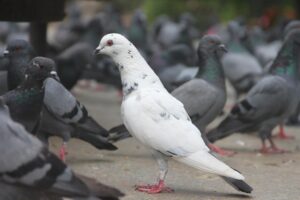
Getting rid of pigeons isn’t easy because they have a natural homing instinct and an attachment to their original birthing and nesting sites. A pigeon typically lays two eggs a month and breeds many times a year so a small pigeon problem can quickly escalate into a large one. Getting rid of pigeons is not as simple as destroying their nests or trapping them and releasing them elsewhere.
Pigeons can simply be a nuisance but at worst, they can be a health and safety hazard. They can carry disease and their droppings are corrosive and destructive to building structures. The method you use to deal with your pigeon problem will depend on the size of your site and the specific circumstances. Most people resort to products such as those at https://www.flyawaybms.com/Weather-Caps-Hangers.aspx.
Exclusion solutions
Proactive use of exclusion solutions is easier than trying to remove pigeons once they have made themselves at home. You don’t want them to breed on your property and stay there year after year. They do not migrate and have a natural homing instinct. Some of the most effective methods for pigeon control include exclusion netting, spikes or a mild electric shock.
Exclusion netting will effectively keep pigeons from roosting and building nests in certain spots but it is an expensive option. Bird spikes are hardly visible from a distance and prevent pigeons from getting a foothold when they’re trying to land. A shock track emits a mild electric shock that doesn’t hurt but is enough to keep pigeons away and prevent them from coming back.
Repellent solutions

Using repellents is another way to deal with pigeons. Gels, pastes, fogs, and vapors are some of the repellents on the market. Applying sticky gels and pastes to perching areas can persuade pigeons not to roost. Fogs and vapors work in large indoor areas but the effect isn’t consistent. Gels often become covered in debris so they don’t work as well and need to be reapplied. Small birds can also get trapped by them.
Visual and auditory solutions
Visual solutions that produce direct or reflective light come in many forms. In residential areas, people often use homemade solutions such as aluminum foil strips, CDs or little mirrors. In industrial areas, lasers may produce the same effect. The light disturbs the sensitive eyes of pigeons and keeps them away.
Another visual solution is to use effigies of birds of prey that are pigeon predators. These effigies or decoys come in many different sizes, forms, and some of them even have moving parts. Unfortunately, they only work until the pigeons get used to them and realize they aren’t really a threat.
Auditory solutions like ultrasonic emitters emit sounds that disturb and irritate the ears of pigeons and keep them away. Propane cannons have the same effect and are used in areas where exclusion isn’t practical. However, the pigeons can acclimatize to the sounds so they work less well over time. One of the disadvantages of using ultrasonic emitters is that they can disturb bat populations.
Culling and trapping
Your pigeons may irritate you so much that your first instinct is to want to shoot them. Shooting them may offer an instantaneous solution but it won’t really solve your problem over the long term due to the prolific breeding habits of pigeons. It won’t take long for the population to be right back where it was before.
Trapping the pigeons and releasing them elsewhere is also problematic. Their innate homing instinct means that they will find their way back. They can also become ‘trap shy,’ and it becomes more difficult to get them into the traps. Public relations issues that may arise from trapping and killing pigeons and resorting to poisons come with a number of risks.
Pigeon birth control

Pigeon birth control provides an effective way to reduce the pigeon population. OvoControl offers OvoControl P, which is contraception that is ingested by pigeons and interferes with egg fertilization in females. An automatic feeder is ideally placed on a rooftop and once the birds eat the pellets, it releases on a regular basis. The active ingredient in the pellets builds up in the systems of the females. This decreases population growth in a humane and cost-effective way. Treated sites typically experience a 50% decrease in the flock each year and this occurs gradually over time.
Conclusion
If you want to solve your pigeon problem, there are many different methods you can use. Some methods are suitable for a limited number of pigeons in a small area, whereas others work better on large industrial sites. Controls such as spikes, bird netting and shock tracks may work in small areas, such as on residential rooftops. However, they do nothing to reduce the pigeon population. For large pigeon populations, it makes sense to use a method that reduces it over time until it is no longer an issue.






